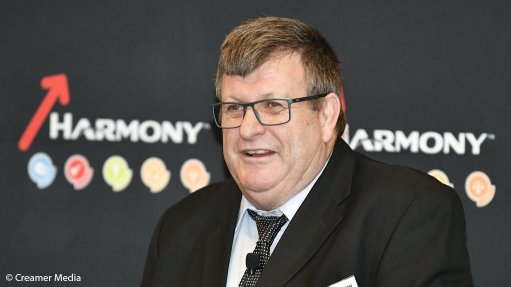
Peter Steenkamp
Photo by: Creamer Media's Donna Slater
Gold mining company Harmony expects to have a 30 MW solar power plant running a year from now, provided all regulatory obstacles are removed. The company is also in discussion with Eskom to alleviate the impact of load-shedding.
Harmony CEO Peter Steenkamp said during a media conference, covered by Engineering News & Mining Weekly, that the 30 MW plant in the Free State would be the first step in the company’s move to arrange for its own electricity generation.
“We’re already far down the line as far as identifying the company that will build it for us and, obviously, our offtake agreements with them.
“In future , we can potentially do another 40 MW, which is already designed. If we get the go-ahead very soon, by the end of the financial year, we should be in a position to start building and, in a year from now, we’ll have a 30 MW plant up and running,” Steenkamp said.
In an interview with Mining Weekly a year ago, Harmony sustainable development executive Melanie Naidoo-Vermaak revealed that the company had gone out on procurement for the 30 MW solar plant, earmarked for Welkom.
Electricity represents 16% of Harmony’s total operational costs, which is why the company has placed so much emphasis on reducing electricity consumption, and now also on environmental protection.
The 30 MW was 10% of Harmony’s power requirements at the time. Since then, the company has acquired the Moab Khotsong underground gold mine from AngloGold Ashanti.
“Obviously, with Moab, it is bigger than 10%, so we certainly would like to increase our self-sustainability as far as electricity is concerned,” Steenkamp clarified last week.
In response to Nedbank CIB market research analyst Arnold van Graan during question time, after Harmony’s presentation of its half-year results, Steenkamp added that he believed all regulatory hurdles would be scaled in a month or two to allow the company to start the solar programme.
“We won’t build the solar plant with our own capital. It will be somebody else that will build it for us,” Steenkamp said.
From a cost perspective, solar presents a business case in competing with Eskom.
“Once construction is complete, solar will come in at below Eskom prices,” Naidoo-Vermaak said last year.
On discussions with Eskom to alleviate the impact of continuous Stage1 and Stage 2 load-shedding, Steenkamp said: “What worries us at the moment is that we have this continuous Stage 1 or Stage 2 load-shedding, which means we have to cut about 10% of our power use, and that’s not a good outcome for us because what normally happened in the past is that we could make up what we had lost over weekends or make up at night, when there is no load-shedding.
“Having this continuous load-shedding is a problem for us. We’re in a discussion with Eskom to try to see how we can alleviate that and see how we can manage it better.
“If we have to cut back on production, we would do so at our high-cost mines, which are close to the end of their life, typically Masimong and Unisel. But we can also cut back on waste retreatment, which we can always leave to a later date.
“The continuous Stage 1 and Stage 2 load-shedding is not a good outcome for the mining industry if it means continuous cutback on production,” he said.
“Our biggest consumption is on refrigeration, pumping and the delivery of compressed air to the mines, and those you cannot just switch on and off. “The refrigeration needs to be run all the time and the moment you switch it off, the mine heats up and you cannot mine.
“The things you can play with are really milling and hoisting to do those cuts, and that is what we need to have on the way forward with Eskom, because every day if they say, ‘Cut 10%, cut 10%, cut 10%’, we are going to run into trouble.”